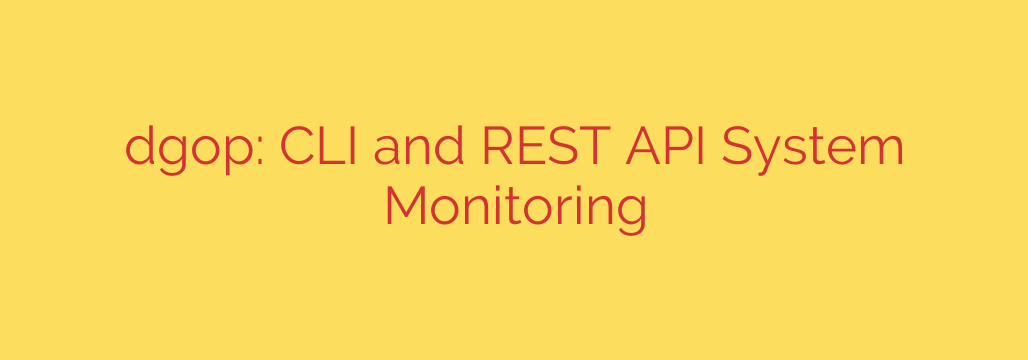
Simplify Server Monitoring with a Lightweight CLI and API Tool
In today’s complex IT environments, maintaining visibility into your system’s health is not just a best practice—it’s a necessity. From tracking resource utilization to diagnosing performance bottlenecks, effective system monitoring is the cornerstone of a stable and reliable infrastructure. While many comprehensive solutions exist, they can often be resource-intensive and overly complex for everyday needs.
A modern, streamlined approach combines the immediacy of a command-line interface (CLI) with the flexibility of a REST API. This dual-interface model provides system administrators, DevOps engineers, and developers with the exact data they need, precisely how they need it.
The Dual-Interface Advantage: Instant Access and Automation
The true power of a modern monitoring tool lies in its flexibility. By offering both a CLI and an API, it caters to two critical use cases: manual spot-checks and automated workflows.
For Instant Insights: The Command-Line Interface (CLI)
When you need a quick, real-time snapshot of your server’s health, nothing beats the command line. A well-designed CLI tool allows you to SSH into a machine and immediately get a clear overview of vital statistics without navigating a heavy graphical interface. This is ideal for troubleshooting active issues, performing routine health checks, or simply getting a feel for a system’s current load.For Automation and Integration: The REST API
The game-changer for modern infrastructure management is programmatic access to system metrics. A REST API endpoint that exposes system data in a structured format (like JSON) unlocks a world of possibilities. You can integrate server statistics directly into custom dashboards, feed data into alerting systems, or build automated scripts that react to specific performance thresholds. This makes it easy to centralize monitoring for your entire fleet of servers.
Key System Metrics at Your Fingertips
A lightweight monitoring solution should provide comprehensive data without unnecessary overhead. Here are the essential metrics you should be able to access instantly:
- CPU and Load Average: Get detailed statistics on CPU usage, including individual core performance and overall system load averages over time. This is critical for identifying processes that are consuming excessive CPU cycles.
- Memory Analysis: Track total, used, and free memory (RAM) as well as swap space utilization. Understanding memory consumption is key to preventing system slowdowns and crashes.
- Disk Usage and I/O: Monitor disk space to avoid running out of storage. More importantly, track disk read/write operations (I/O) to identify storage bottlenecks that could be slowing down your applications.
- Network Statistics: View information on network interfaces, including data sent and received. This helps in diagnosing connectivity issues and monitoring bandwidth usage.
- Host and OS Information: Quickly retrieve essential system details like the hostname, operating system version, kernel version, and system uptime.
- Running Processes: List and inspect active processes to understand what software is currently running and how many resources it is consuming.
Actionable Security Tips for Your Monitoring Endpoint
Exposing system metrics via a REST API is incredibly powerful, but it must be done securely. Leaving a monitoring endpoint open to the public internet is a significant security risk. Here are essential steps to protect your monitoring API:
Never Expose the API Directly: Do not bind the monitoring service to a public IP address. Instead, have it listen on the local interface (
localhostor127.0.0.1). This ensures it can only be accessed from the server itself.Use a Reverse Proxy: Place a secure web server like Nginx or Caddy in front of your monitoring API. A reverse proxy can handle SSL/TLS encryption, add authentication, and control access.
Implement IP Whitelisting: Configure your firewall (e.g.,
ufw,iptables) or reverse proxy to only allow connections from trusted IP addresses, such as your office network or a central management server.Enforce Authentication: Secure the API endpoint with an authentication mechanism. Using API keys or bearer tokens that must be included in the request header is a standard and effective practice.
Encrypt Traffic with HTTPS: Always use SSL/TLS to encrypt the data transmitted between your API client and the server. This prevents eavesdropping and man-in-the-middle attacks.
By implementing these security layers, you can safely leverage the power of an API for monitoring without exposing sensitive system information.
A Modern Solution for a Modern Need
Ultimately, effective system monitoring is about having access to the right data at the right time. A lightweight tool built in a high-performance language like Go, offering both a CLI for quick checks and a REST API for automation, provides the perfect balance of simplicity and power. It empowers teams to be proactive about performance, faster in troubleshooting, and smarter in how they manage their infrastructure.
Source: https://www.linuxlinks.com/dgop-system-monitoring-tool/








